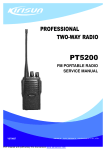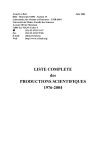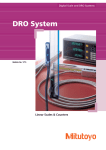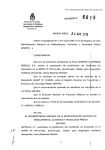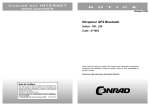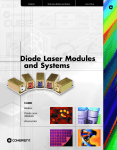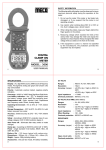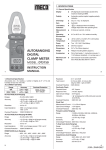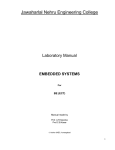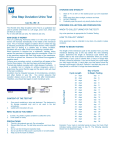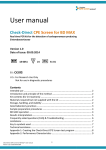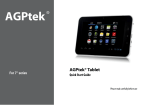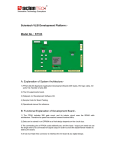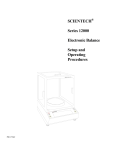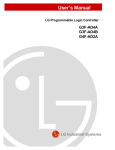Download OI - JNEC
Transcript
Jawaharlal Nehru Engineering College Laboratory Manual OPTICAL INSTRUMENTATION For Final Year Students Author JNEC INSTRU DEPT., Aurangabad 1 This manual is intended for the final year students of instrumentation in the subject Optical Instrumentation. Manual typically contains practical/Lab Sessions related Measurement System fundamentals covering various aspects related the subject to enhanced understanding. Students are advised to thoroughly go though this manual rather than only topics mentioned in the syllabus as practical aspects are the key to understanding and conceptual visualization of theoretical aspects covered in the books. Good Luck for your enjoyable laboratory sessions. 2 DOs and DON’T DOs in Laborary: 1. Do not handle any equipment before reading the instructions/Instruction manuals 2. Read carefully the power ratings of the equipment before it is switched on whether ratings 230 V/50 Hz or 115V/60 Hz. For Indian equipments, the power ratings are normally 230V/50Hz. If you have equipment with 115/60 Hz ratings, do not insert power plug, as our normal supply is 230V/50 Hz, which will damage the equipment. 3. Observe type of sockets of equipment power to avoid mechanical damage 4. Do not forcefully place connectors to avoid the damage 5. Strictly observe the instructions given by the teacher/Lab Instructor Instruction for Laboratory Teachers:: 1. Submission related to whatever lab work has been completed should be done during the next lab session. The immediate arrangements for printouts related to submission on the day of practical assignments. 2. Students should be taught for taking the printouts under the observation of lab teacher. 3. The promptness of submission should be encouraged by way of marking and evaluation patterns that will benefit the sincere students. 3 INDEX 1. To study Optical fiber 2. To study Sources of light for Optical fiber 3. To study characteristics of Photovoltaic cell.. 4. To study characteristics of Photoconductive Cell. 5. To study characteristics of PIN Photodiode 6. To study characteristics of phototransistors. 7. To study the Holography 8. To study the Turbidity Meter 9. To study the Optical Devices. 10. Study of Flame Photometer. 4 5 Experiment No.1 Study of Optical Fiber Aim: To study Optical fiber. Apparatus: Optical fiber, Cutter, light source, etc Theory: An optical fiber (or fiber) is a glass or plastic fiber that carries light along its length. Fiber optics is the overlap of applied science and engineering concerned with the design and application of optical fibers. Optical fibers are widely used in fiber-optic communications, which permits transmission over longer distances and at higher bandwidths (data rates) than other forms of communications. Specially designed fibers are used for a variety of other applications, including sensors and fiber lasers. Light is kept in the core of the optical fiber by total internal reflection. This causes the fiber to act as a waveguide. Fibers which support many propagation paths or transverse modes are called multi-mode fibers (MMF), while those which can only support a single mode are called single-mode fibers (SMF). Multi-mode fibers generally have a larger core diameter, and are used for short-distance communication links and for applications where high power must be transmitted. Singlemode fibers are used for most communication links longer than 550 meters (1,800 ft). Principle of operation An optical fiber is a cylindrical dielectric waveguide (non conducting waveguide) that transmits light along its axis, by the process of total internal reflection. The fiber consists of a core surrounded by a cladding layer, both of which are made of dielectric materials. To confine the optical signal in the core, the refractive index of the core must be greater than that of the cladding. The boundary between the core and cladding may either be abrupt, in step-index fiber, or gradual, in graded-index fiber Total internal reflection Total internal reflection is an optical phenomenon that occurs when a ray of light strikes a medium boundary at an angle larger than a particular critical angle with respect to the normal to the surface. If the refractive index is lower on the other side of the boundary, no light can pass through and all of the light is reflected. The critical angle is the angle of 6 incidence above which the total internal reflection occurs. When light traveling in a dense medium hits a boundary at a steep angle (larger than the "critical angle" for the boundary), the light will be completely reflected. This effect is used in optical fibers to confine light in the core. Light travels along the fiber bouncing back and forth off of the boundary. Because the light must strike the boundary with an angle greater than the critical angle, only light that enters the fiber within a certain range of angles can travel down the fiber without leaking out. This range of angles is called the acceptance cone of the fiber. The size of this acceptance cone is a function of the refractive index difference between the fiber's core and cladding. In simpler terms, there is a maximum angle from the fiber axis at which light may enter the fiber so that it will propagate, or travel, in the core of the fiber. The sine of this maximum angle is the numerical aperture (NA) of the fiber. Fiber with a larger NA requires less precision to splice and work with than fiber with a smaller NA. Single-mode fiber has a small NA. Fig1.Cross Section of Optical Fiber 7 Special-purpose fiber Some special-purpose optical fiber is constructed with a non-cylindrical core and/or cladding layer, usually with an elliptical or rectangular cross-section. These include polarization-maintaining fiber and fiber designed to suppress whispering gallery mode propagation. Photonic crystal fiber is made with a regular pattern of index variation (often in the form of cylindrical holes that run along the length of the fiber). Such fiber uses diffraction effects instead of or in addition to total internal reflection, to confine light to the fiber's core. The properties of the fiber can be tailored to a wide variety of applications. Materials Glass optical fibers are almost always made from silica, but some other materials, such as fluorozirconate, fluoroaluminate, and chalcogenide glasses, are used for longer-wavelength infrared applications. Like other glasses, these glasses have a refractive index of about 1.5. Typically the difference between core and cladding is less than one percent. Properties of Optical Fiber. 1.Numerical Aperture of any type of fiber is defined as: where n1 =is the refractive index along the central axis of the fiber(core). n 2= refractive index of cladding 2. Attenuation 3. Dispersion 3. Fiber strength 4. Band width parameters 5.Rise Time 8 Applications and Advantages 1. Optical fiber can be used as a medium for telecommunication and networking because it is flexible and can be bundled as cables. 2. It is especially advantageous for long-distance communications, because light propagates through the fiber with little attenuation compared to electrical cables. This allows long distances to be spanned with few repeaters. 3. Additionally, the per-channel light signals propagating in the fiber can be modulated at rates as high as 111 gigabits per second,] although 10 or 40 Gb/s is typical in deployed systems. 4. Each fiber can carry many independent channels, each using a different wavelength of light (wavelength-division multiplexing (WDM)). 5. The net data rate (data rate without overhead bytes) per fiber is the per-channel data rate reduced by the FEC overhead, multiplied by the number of channels (usually up to eighty in commercial dense WDM systems as of 2008). The current laboratory fiber optic data rate record, is multiplexing 155 channels, each carrying 100 Gbps over a 7000 km fiber. Conclusion:-Hence Optical fiber is studied in detail. 9 Experiment No.2 Sources of light for Optical fiber Aim: To study Sources of light for Optical fiber Theory: Optical source is often considered to be the active component of an OFC system. Its function is to convert electrical energy in the form of current into optical energy, in efficient manner into the fiber. Three main types of optical fibers sources are 1. Wideband continous spectra sources(incandescent lamps) 2. Monochromatic incoherent sources (Light Emitting Diodes) 3. Monochromatic coherent sources (Lasers) For optical Fiber communications LED’s and LASERS are preferred sources. 1. Light Emitting Diodes: Construction and working principle: The LED consists of an encapsulated chip of semiconductor diode with a suitable lens. The length of Anode terminal is greater than cathode terminal. LEDs are based on the semiconductor diode. When the diode is forward biased (switched on), electrons are able to recombine with holes and energy is released in the form of light. This effect is called electroluminescence and the color of the light is determined by the energy gap of the semiconductor. The LED is usually small in area (less than 1 mm2) with integrated optical components to shape its radiation pattern and assist in reflection 10 Fig 1.Working Principle of LED Material for LED In case of LED different materials are used to get the radiation in infrared region and in the visible region. To get radiation in infrared region Ga As material is used Sometimes the combination Ga As with indium and aluminium is used. It gives the wavelength as follows: In Ga As------8500 Angstrom Al Ga as-------9000 Angstrom Advantages of LED 1. They are small in size and light in weight. 2. They are mechanically rugged and have low operating temperature. 3. No complex driving circuitry is required. 4. Have high switching speed and are available in different colours. 5. Linearity is more and compatible with integrated circuits. 11 Disadvantages of LED 1. Output power gets affected by the temperature variation. 2. Quantum efficiency is low. 3. Gets damaged because of overvoltage and over current. Fig 2.Different types of LED 2. LASER: - (Light Amplification by Stimulated Emission of Radiation) A laser (Light Amplification by Stimulated Emission of Radiation)is a device that emits light (electromagnetic radiation) through a process called stimulated emission. Laser light is usually spatially coherent, which means that the light either is emitted in a narrow, lowdivergence beam, or can be converted into one with the help of optical components such as lenses. More generally, coherent light typically means the source produces light waves that are in step. They have the same frequencies and identical phase. ABSORPTION, SPONTANEOUS AND STIMULATED EMISSION 12 In general, when an electron is in an excited energy state, it must eventually decay to a lower level, giving off a photon of radiation. This event is called “spontaneous emission,” and the photon is emitted in a random direction and a random phase. The average time it takes for the electron to decay is called the time constant for spontaneous emission, and is represented by t. On the other hand, if an electron is in energy state E2, and its decay path is to E1, but, before it has a chance to spontaneously decay, a photon happens to pass by whose energy is approximately E24E1, there is a probability that the passing photon will cause the electron to decay in such a manner that a photon is emitted at exactly the same wavelength, in exactly the same direction, and with exactly the same phase as the passing photon. This process is called “stimulated emission.” Absorption, spontaneous emission, and stimulated emission are illustrated in figure .Now consider the group of atoms shown in figure below. All begin in exactly the same excited state, and most are effectively within the stimulation range of a passing photon. We also will assume that t is very long, and that the probability for stimulated emission is 100 percent. The incoming (stimulating) photon interacts with the first atom, causing stimulated emission of a coherent photon; these two photons then interact with the next two atoms in line, and the result is four coherent photons, on down the line. At the end of the process, we will have eleven coherent photons, all with identical phases and all traveling in the same direction. In other words, the initial photon has been “amplified” by a factor of eleven. Note that the energy to put these atoms in excited states is provided externally by some energy source which is usually referred to as the “pump” source. 13 Fig 3. Absorbtion, Spontaneous emission and stimulated emission mechanism POPULATION INVERSION Atomic energy states are much more complex than indicated by the description above. There are many more energy levels, and each one has its own time constants for decay. The four-level energy diagram shown in figure 4. is representative of some real lasers. The electron is pumped (excited) into an upper level E4 by some mechanism (for example, a collision with another atom or absorption of high-energy radiation). It then decays to E3, then to E2, and finally to the ground state E1. Let us assume that the time it takes to decay from E2 to E1 is much longer than the time it takes to decay from E2 to E1. In a large population of such atoms, at equilibrium and with a continuous pumping process, a population inversion will occur between the E3 and E2 energy states, and a photon entering the population will be 14 amplified coherently. Fig.4 Amplification by stimulated emission Advantages of LASER over other Light Sources: 1. LASER light has narrow spectral bandwidth. 2. Light is coherent and monochromatic 3. LASER light has good directionality. 4. More percentage of the LASER light is in the visible range as compared to conventional lamps. 5. LASER has high quantum efficiency and high modulation rate. 6. LASERS are point source of light. 7. LASER has excellent stability. 8. LASER light can be modulated externally or it has ability of direct modulation. 15 Types of LASERs According to the type of material used for the formation of LASER beam, the LASERs are classified as the solid state laser, gaseous laser, power lasers and semiconductor LASERs. A] Solid State LASERS 1. Ruby Laser 2. Nd: YAG Laser B] Semiconductor LASER C] Gas LASERs 1. Helium-Neon Lasers 2. Carbon Dioxide Laser Conclusion: Thus, sources of light are studied in detail. 16 Experiment No.3 Characteristics of Photovoltaic Cell AIM: To study characteristics of Photovoltaic cell. APPARATUS: Optical Transducers Trainer kit ST 2301(SCIENTECH) THEORY: PROCEDURE: 1. Connect the circuit as shown in diag.2 a) The socket C of Wire Wound pot. to +12V. b) The socket A of Wire Wound pot. to 0V. c) The socket B of wirewound pot. to input of Power Amplifier. d) The output of Power Amplifier to input of Lamp Filament. e) The other input of filament lamp to +ve input of Moving Coil Meter. f) The –ve ve input of Moving Coil Meter to 0V. g) Output of Photovoltaic Cell to 0V through a Digital Multimeter connected as an Ammeter at 2mA range, to measure short circuit current of photovoltaic cell. 17 2. Switch ON the power supply & set the 10KΩ 10K wire wound pot. to minimum for zero output voltage from Power Amplifier. 3. Place the opaque box over the plastic enclosure to exclude all ambient light. Take readings of Photovoltaic cell short circuit output current as indicated indicated as Digital Multimeter as lamp voltage is increased in 1V steps. Record results in table 1. 4. Switch OFF the power supply & set the Digital multimeter as a voltmeter at 2/20 V DC range to read the open circuit output voltage. 5. Switch ON the power supply supply and take the readings adding results to table1. 6. Switch OFF the power supply. 7. Plot the graphs of photovoltaic cell short circuit current & open circuit voltage against Lamp Filament voltage. It should resemble the one given graph. OBSERVATION: GRAPH: CONCLUSION: 18 Experiment No.4 Characteristics haracteristics of Photoconductive Cell AIM: To study characteristics of Photoconductive Cell. APPARATUS: Optical Transducers Trainer kit ST 2301(SCIENTECH) THEORY: 19 CHARACTERISTICS: The device used on ST2301 is ORP12. Its characteristics are given below: PROCEDURE: 1. Connect the circuit as shown in diag.2 a) The socket C of Wire Wound pot. to +12V. b) The socket A of Wire Wound pot. to 0V. c) The socket B of wirewound pot. to input of Power Amplifier. 20 d) The output of Power Amplifier to input of Lamp Filament. e) The other input of filament lamp to +ve input of Moving Coil Meter. f) The –ve ve input of Moving Coil Meter to 0V. g) Connect C Socket of Slide Potentiometer to +5V. h) Output of Photoconductive Cell to B input of Slide Potentiometer. i) Connect a Digital Multimeter as voltmeter on 20V DC range to measure the Photoconductive cell output voltage between output of photoconductive cell and 0V. 2. Set the 10KΩ Slide Potentiometer setting to 3 so that the the photoconductive cell load resistance is approximately 3KΩ.(can 3K be verified with DMM) 3. Place the opaque box over the plastic enclosure to exclude all ambient light. 4. Switch ON the power supply & set the wire wound pot. to minimum for zero output voltage ge from Power Amplifier. 5. Take readings of Photoconductive cell short circuit output current as indicated as Digital Multimeter as lamp voltage is increased in 1V steps. Record results in table 1. 6. Switch OFF the power supply. 7. Plot the graphs of photoconductive photoconductive cell short circuit current & open circuit voltage against Lamp Filament voltage. It should resemble the one given graph. OBSERVATION: GRAPH: 21 CONCLUSION: 22 Experiment No.5 Characteristics of PIN Photodiode AIM: To study characteristics of PIN Photodiode. APPARATUS: Optical Transducers Trainer kit ST 2301(SCIENTECH) THEORY: 23 CHARACTERISTICS: 24 PROCEDURE: 1. Connect the circuit as shown in diag. a) The socket C of Wire Wound pot. to +12V. b) The socket A of Wire Wound pot. to 0V. c) The socket B of wirewound pot. to input of Power Amplifier. d) The output of Power Amplifier to input of Lamp Filament. e) The other input of filament lamp to +ve input of Moving Coil Meter. f) The –ve input of Moving Coil Meter to 0V. g) Output of PIN photodiode to input of Current Amplifier which is used to measure the current output of the PIN Photodiode. h) Output of current amplifier to input of DC amplifier. i) Connect a Digital Multimeter as voltmeter on 20V DC range between output of DC Amplifier and 0V to measure the output voltage of DC amplifier. 2. Place the opaque box over the plastic enclosure to exclude all ambient light. 3. Switch ON the power supply & set the 10KΩ wire wound pot. to minimum for zero output voltage from Power Amplifier. 4. Adjust OFFSET control of DC Amplifier to read zero in DMM Meter for zero input at DC Amplifier. 5. Take readings of Amplifier output voltage on the Digital Multimeter as lamp voltage is increased in 1V steps. Record results in table 1. 6. Switch OFF the power supply. 7. Change the Current Amplifier to Buffer to measure output of PIN photodiode. Take readings of PIN photodiode output voltage as the lamp voltage is increased in 1V step, record the result in table. Remember, to adjust the offset of DC amplifier is giving zero output for zero input. 8. Plot the graph between PIN photodiode current amplifier output voltage, buffer amplifier output voltage & Lamp Filament voltage. It should resemble the one given below. 25 OBSERVATION: GRAPH: CONCLUSION: 26 Experiment No.6 Characteristics of Phototransistors AIM: To study characteristics of phototransistors. APPARATUS: Optical Transducers Trainer kit ST 2301(SCIENTECH) THEORY: 27 CHARACTERISTICS: 28 PROCEDURE: 1. Connect the circuit as shown in diag. a) The socket C of Wire Wound pot. to +12V. b) The socket A of Wire Wound pot. to 0V. c) The socket B of wirewound pot. to input of Power Amplifier. d) The output of Power Amplifier to input of Lamp Filament. e) The other input of filament lamp to +ve input of Moving Coil Meter. f) The –ve ve input of Moving Coil Meter to 0V. g) Connect +5V to C input of slide potentiometer. h) Connect B input of the slide potentiometer to Output of Phototransister. i)) Connect a Digital Multimeter as voltmeter between output of phototransister & ground on 20V DC range to measure the phototransistor output voltage. 2. Set the 10KΩ slide potentiometer control to minimum setting(1) so that the phototransistor load d resistance is approximately 1KΩ(protection resistor only). 3. Fit an opaque box over the clear plastic enclosure to exclude all ambient light. 29 4. Switch ON the power supply & set the 10KΩ wire wound pot. to minimum for zero output voltage from Power Amplifier. Amplifier 5. Take readings of phototransistors output voltage as indicated on the Digital Multimeter as lamp voltage is increased in 1V steps. Record results in table 1. 6. Switch OFF the power supply. 7. Plot the graph of phototransistor output voltage against Lamp Filament Filament voltage. It should resemble the one given below. OBSERVATION: GRAPH: CONCLUSION: 30 Experiment No.7 An Assignment on Holography Aim: To study the Holography Theory:Holography is the recording of visible object in terms of light wave phenomena. Unlike the photographic recording the recorded object seems to be as it was originally. In photographic, only two dimensions of object can be preserved which losses various important details of it. Holography overcome the difficulty by recording the same in terms of wave parameter i.e amplitude and phase shift. This information once recorded remain unaltered. It can be brought on the holographic medium as a pattern of interference of two phase viz refrenece beam and reflected beam. This words was introduced by the Greek letters holus- whole and graphy- writing. The entire holography can be divided into two part. 1) Holographic recording 2) Image reconstruction LASER is required for the same by virtue of its good coherence, monochromacity and directionality. (student are suppose to study holography indepth and have to be written in there own words on the basis of the following points) 1) Need and history of holography 2) The light source 3) Holographic media 4) Principle of working and related theory 5) Various features 6) Applications 31 Experiment No.8 Case study of Turbidity Meter Aim:-To study the Turbidity Meter Theory:The case study is evidence of study the turbidity meter practically. Mainly the focus given to the technical and design aspects of turbidity meter. Available turbidity meters should be refered but sufficient technical information is not covered with the user manual hence student have to search related on the refrence books and internet search. Following point should be described in the case study:1) Concept of turbidity. 2) Working principle. 3) Constructional features. 4) Sample requirement. 5) Factors affecting measurement. 6) Advantages and disadvantages discussion. 7) Application area discussion. 8) Sample experimentation possible on the meter. 9) Cost and manufacturer. 32 Experiment No.9 An Assignment on Optical Devices Aim:-To study the Optical Devices. Apparatus:- LED, LCD and there required circuit. Theory:The assignment would be the evidence of detailed study of the devices like, LED, LCD. As these devices are widely used in optical instrumentation and communication. This study should be followed following points. 1) Working principle 2) Material used 3) Sectional views/schematics/Blocks diagram 4) Mounting 5) Circuit 6) Working 7) Features 8) Application Color illustration given along with will be encouraged. The objective is to provoke the student for extra learning and detail approach of the knowledge. 33 EXPERIMENT NO 10 Study of flame photometer. AIM: To study flame photometer. APPARATUS: flame photo meter kit THEORY: Flame photometry is based on the measurement of light emitted or photons emitted when a metal is introduced into a flame. The colour of wavelength a intensity gives the constituents of the element. The above figure shows the schematic diagram of simple modified flame photometer. As shown in above figure it consist of a burner of total combustion type, a collimating mirror, a monochromator ( a prism) and detector system consist of a photodetector followed by amplifier and readout system. Working: An atomizer operated by one of the flame producing gases sucks the sample solution. The sample is aspirated into the flame in form of a fine spray. Spectral emission 34 comes form the excited atoms formed during the process of combustion. This emitted radiation is collected by collimating concave mirror from the flame and is allowed to pass through prism and slit. The radiation of appropriate wavelength strikes on photo-detector and the magnitude of electrical signals are read on meter. APPLICATIONS: - 1) 2) 3) 4) Qualitative analysis. Quantitative analysis. Simultaneous multi element analysis. Miscellaneous analysis. 35



































